If ever you catch quite a beginner and want to give him a taste for botany tell him to make a perfect list of some little field or wood. Both Miss Thorley and I agree that it gives a really uncommon interest to the work, having a nice little definite world to work on, instead of the awful abyss and immensity of all British Plants. Charles Darwin in a letter to Joseph Hooker -director of Kew Gardens You will have realised from the quote above that the general theme of this blog is to study one area in detail rather than looking far and wide. In particular, to study the wild flowers that grow in the ' nice little definite world ' of Leazes Park and where possible take a Darwinian perspective on matters. It is well known that in the early part of his career Darwin traveled far and wide on board HMS Beagle. Less well known, however, are his studies in his garden and its immediate surroundings and the influence those studies had on the formulation of his theory of evolution by natu
Posts
Hedge Woundwort
- Get link
- Other Apps
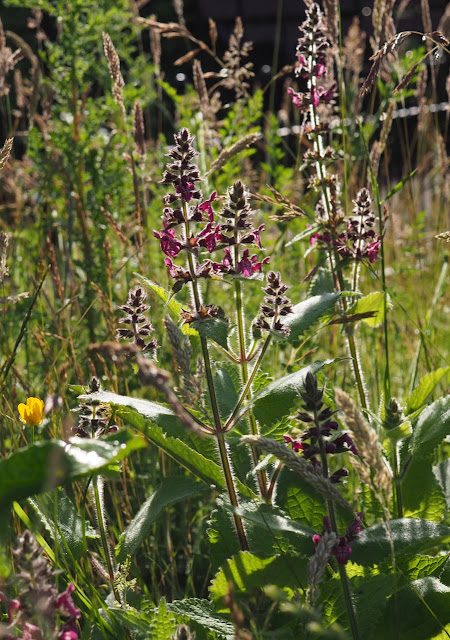
Stachys sylvaticus A distilled water of the flowers makes the heart merry, to make good a colour in the face and to make the vitall spirits more fresh and lively Nicholas Culpeper 1514-1541 Some people dislike hedge woundwort on account of its unpleasant smell and the nettle-like appearance of its leaves but as long as you don’t crush the leaves you can avoid the smell and although the leaves look nettle like they are pleasantly downy to touch. In fact, I like hedge woundwort and if you get up close to the flowers they have a beauty that is the equal of any orchid. For that reason, you should take time to get at eye level with the flowers and enjoy their rich, marbled purple red colour. Don’t be tempted to pick the flowers or crush the leaves though, on account of that smell. Hedge woundwort in the early morning sun. Taxonomy Hedge woundwort belongs to the Lamiaceae or dead-nettle family, look closely at it and you will see that it has features in common with other family members th
Hogweed
- Get link
- Other Apps
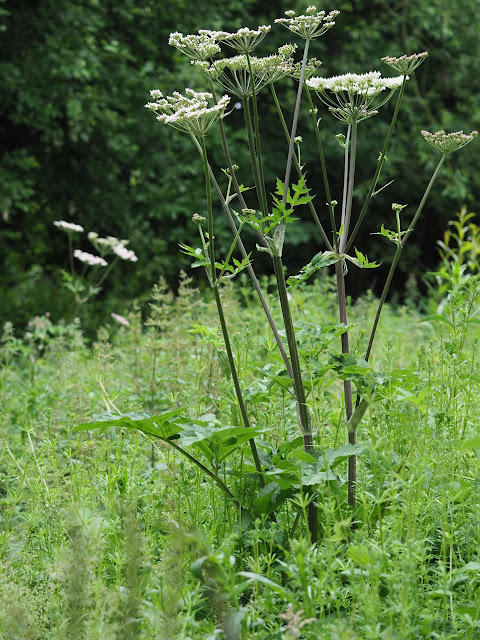
Heracleum spondylium Despite the unattractive sounding popular name, Hogweed is a magnificent plant whose popular name derives from the unpleasant piglike smell of the flowers rather than reflecting a coarse or ugly appearance. It is the largest of the Apiaceae or umbellifers that are to be found in Leazes Park and in high summer the flat discs of flowers can be above my head. Although you seldom find it in its full glory it does put in an appearance at other times of the year. I have found it during New Year plant hunts and I was prompted to start writing this post by a reappearance of the plant in late October 2020. In spite of the unpleasant fragrance of the mature flowers, the young shoots are supposed to make good eating but I would discourage anyone from eating members of this family harvested from the park. You only have to get it wrong once..... Taxonomy Hogweed belongs to the Apiaceae family that was discussed in a previous blog post. Other members of this family that have
Wild Carrot
- Get link
- Other Apps
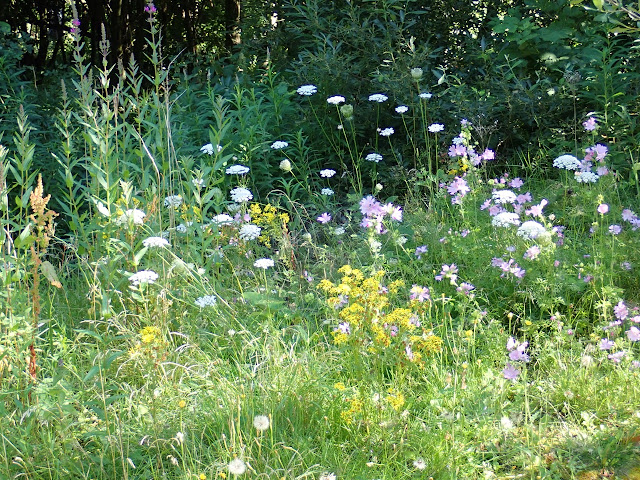
Daucus carrota ............It is a field of the wild carrot taking the field by force; the grass does not rise above it. William Carlos Williams ‘Queen Anne’s Lace’ 1921 One of the most striking and photogenic members of the umbellifers is wild carrot or Daucus carrota and it is a flower that repays regular visits as the inflorescence develops, fades then forms its fruits. Indeed, it is perhaps at its most magnificent in late summer and early autumn when the fruits are forming. Wild carrot normally likes dry chalky soils, in spite of this, there is plenty of it to be found in Leazes Park if you know where to look. The roots are thin and wiry and bear little resemblance to the orange taproots you can buy in the supermarket. It is thought that the latter was bred from a distinct subspecies that is found in the Mediterranean ssp sativus that, fortunately for us, has a thicker and sweeter roo
Fat-hen
- Get link
- Other Apps

Chenopodium album I'll no more go roaming, no more seeking, No more crushing goosefoot in the wood. With those oatsheaf locks you tossed when speaking You have vanished from my dreams for good. Poem by Sergey Yesenin (translated from Russian). It is easy to walk past this initially inconspicuous and commonplace flower that appears in the park just as summer is coming to a close and autumn is getting started. However, if you do see it you should stop and take a closer look and perhaps come on further occasions and watch it develop. Fat-hen ( Chenopodium album ) growing near Barrack road Taxonomy Fat-hen belongs to what used to be called the Goosefoot family or Chenopodiaceae but is now in the Amaranthaceae. There are a lot of members of this family that can look similar including good King-Henry ( Chenopodium bonus-henricus ), fig-leaved goosefoot (C.ficifolium), nettle-leaved goosefoot (C.murale) and others. Sometimes people give up trying to separate out different members of th
Purple Loosestrife
- Get link
- Other Apps
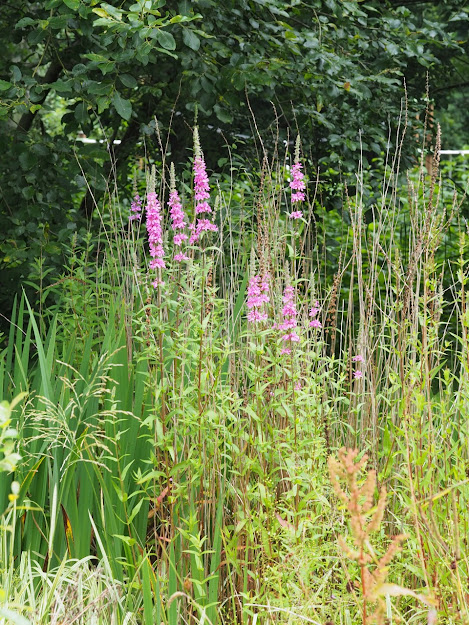
Lythrum salicaria " I am stark staring mad over Lythrum. For the love of Heaven have look at some of your species and if you can get me some seed, do!" Charles Darwin. Letter to Asa Gray The reason for Charles Darwin's puzzlement will become apparent later but bear in mind that when he wrote this in a letter to the American botanist Asa Gray, he had just finished his book on Orchids so we can be sure he was looking at a deeply mysterious arrangement of flower parts. Taxonomy Purple loosestrife belongs to the Lythraceae family which contains 32 genera and 620 species. The type genus is Lythrum or the loosestrifes. The leaves are typically opposite, simple and with pinnate veins . The flowers are radially symmetric and there are usually six petals which often have a rumpled appearance. The family is also remarkable for heterostyly which will be discussed below. Habit Purple Loosestrife or Lythrum salicaria forms tall spires of purple flowers that are u
Rosebay willowherb
- Get link
- Other Apps
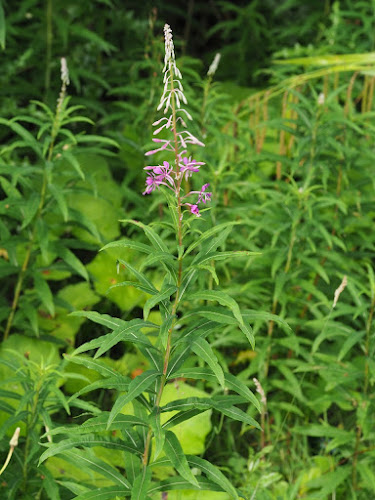
Chamerion angustifolium Rosebay willowherb, Chamerion ( Epilobium in older books) angustifolium is one of the more statuesque plants of late summer. Popular names include Bombweed, Fireweed and Ranting Widow. Rosebay willowherb has not always been common and was formerly considered a rare plant. Now, however, it is one the most successful colonisers of wasteland, car parks and railway verges. It may have spread more widely with the opening up of the railways and come late summer you can see why; bursting from the seed capsules are numerous feathery plumed seeds that are easily spread in the slipstream of trains. Like purple loosestrife, rosebay willowherb forms spires of pink/purple flowers and from a distance, they might even look similar but get up close and there should be no confusing the two. 1. Stand of rosebay willowherb. Taxonomy The willowherbs belong to the Onagraceae family. They have 4 petals and 4 sepals arranged with radial symmetry. The corolla is usually pink